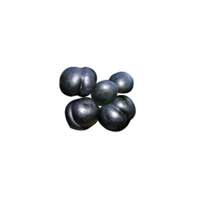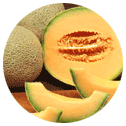 Full List of Fruits
Full List of Fruits  Mountain pepper
Mountain pepperMountain pepper
![]() Introduction of Mountain pepper
Introduction of Mountain pepper
Scientific name - Tasmannia lanceolata
Commonly known as mountain pepper or Cornish pepper leaf, Tasmannia lanceolata is a shrub that is inhabitant to woodlands and cool temperate rainforests of South-eastern Australia. The roots i.e. it is from the family of Winteraceae that are magnoliids. Having said that, they are coupled with the humid Antarctic flora of the Southern Hemisphere! In general, the members of the family have bark and leaves that are sweet-smelling, more importantly the extraction of it are used as an essential oil. The fruit of T. lanceolate is berry-like produce that is of 5-8 mm in diameter. Containing just about 10-18 seeds, they are shiny dark red in color and become black when fully ripe.
![]() Nutritional Value of Mountain pepper
Nutritional Value of Mountain pepper
| Energy | 1630kJ / 100gm |
| H2O | <8 % |
| Protein | 9 gm / 100 gm |
| Fat | 8.5gm / 100 gm |
| Carbohydrates | 68.4 gm / 100 gm |
| Total Sugar | 4.7gm / 100 gm |
| Fibre | N/A |
| Na | 47.35µg |
| K | 1107µg |
| Mg | 142.2µg |
| Ca | 147.8µg |
| Fe | 5.22µg |
| Zn | 3.5µg |
Characteristically referred to as Drimys lanceolata or T. aromatic, colonial Australians used it as the original pepperbush and introduced into cultivation in Cornwall, UK. Later it was associated with Cornish Cuisine. They are high in antioxidants. With a strong peppery flavor, Dorrigo pepper is safrole free which is also sold as a spice. More to the point, it was the original pepperbush used in specialty native food restaurants in the 1980s.
![]() Health Benefits of Mountain pepper
Health Benefits of Mountain pepper
Pepper-berry is known for its anti-inflammatory properties; traditionally it has been used by medical practitioners for arthritis problems. This is because of the “polygodial” compound present in it, which is also thought to have several other beneficial properties as well as the stomach lining and anti-pain activity together being anti-asthmatic. Highly useful for diabetes patients, it also prevents the types of mutation of genetic material.
Mountain pepper fruit is traditionally used in Aboriginal food and medicine. In Aboriginal culture, the fruits are used to season and flavor food, and to make medicines for treating a wide range of ailments. The fruits are also eaten raw and used to make jams, jellies, and other sweet treats.
The fruit is also widely used in the culinary world. It is a popular ingredient in many dishes, especially Tasmanian regional favorites, such as pepperberry ice cream, pepperberry chutney, and pepperberry marinades. It is also often used to flavor sauces and dressings, or as a garnish for salads and desserts.
Mountain pepper fruit is also used in beverages and cocktails. The fruit is usually muddled and added to cocktails, such as the Tasmanian martini, or used to flavor beer and other alcoholic beverages. The fruits are also blended and used to make juices and smoothies.
The plant is also grown in gardens and is marketed as an ornamental species. The shrubs are drought-tolerant and can be grown in a wide range of climates, although they prefer cooler and wetter climates. The fruit is harvested in late summer and can be eaten fresh, or dried and stored for later use.
Mountain pepper fruit is also used in traditional medicines. The fruit has long been used by Aboriginal people to treat a variety of ailments, such as headaches, colds, and digestive issues. The fruits are also believed to have antibacterial, antifungal, and antiviral properties.
Mountain pepper fruit is an important part of Australia's food culture, and is an important ingredient in many dishes. It is a versatile, healthy, and flavorful fruit, and is widely used in many dishes, both traditional and modern. The fruit has a unique flavor and aroma, and can add a unique twist to many dishes.
Mountain pepper can be grown in either containers or in the ground, and prefers a well-draining soil. It is best grown in full sun, but can tolerate a semi-shaded environment. It is a slow-growing shrub and will take several years to reach full size. For best results, the soil should be kept moist but not soggy.
When planting mountain pepper, it is important to provide adequate spacing between plants. It is best to plant them around 10 to 20 feet apart, and in rows that are spaced at least 5 feet apart. Planting too close together can cause overcrowding and competition for resources, which can lead to poor growth and low yields.
Once established, mountain pepper requires little maintenance. Pruning can be beneficial, as it will help the plant retain its shape and encourage the growth of bushy, healthy branches. Pruning should be done in late winter or early spring, before the new growth begins. It may also be necessary to remove any dead or diseased branches.
Mountain pepper fruits are ready to harvest in late summer or early fall. To harvest, the fruits should be picked when they are ripe and just beginning to turn red. The fruits can be stored in a cool, dark place for up to several months.
Mountain pepper is a highly versatile spice, and can be used to add a unique flavor to a variety of dishes. It can be used to season meats, vegetables, and soups, as well as adding a spicy kick to marinades and dressings. It can also be used to make a refreshing tea.
Growing mountain pepper can be a rewarding experience, as it is not only a delicious spice, but it is also an attractive shrub that adds interest to a garden. With proper care and maintenance, it can provide years of enjoyment.


















